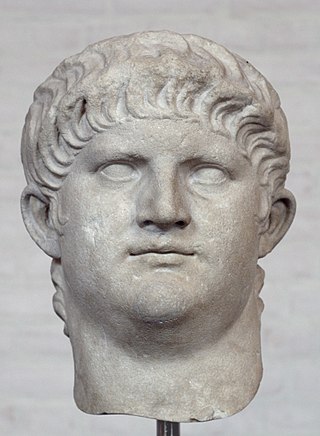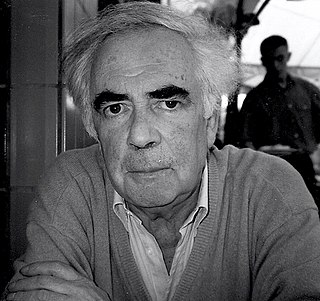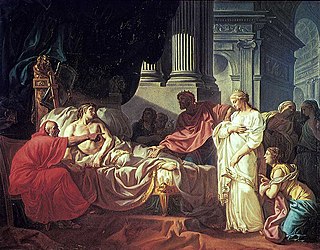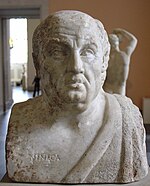
Julia Agrippina, also referred to as Agrippina the Younger, was Roman empress from AD 49 to 54, the fourth wife and niece of emperor Claudius, and the mother of Nero.

Jacques-Louis David was a French painter in the Neoclassical style, considered to be the preeminent painter of the era. In the 1780s, his cerebral brand of history painting marked a change in taste away from Rococo frivolity toward classical austerity, severity, and heightened feeling, which harmonized with the moral climate of the final years of the Ancien Régime.

Nero Claudius Caesar Augustus Germanicus was a Roman emperor and the final emperor of the Julio-Claudian dynasty, reigning from AD 54 until his death in AD 68.

Marcus Annaeus Lucanus, better known in English as Lucan, was a Roman poet, born in Corduba, Hispania Baetica. He is regarded as one of the outstanding figures of the Imperial Latin period, known in particular for his epic Pharsalia. His youth and speed of composition set him apart from other poets.

Lucius Annaeus Seneca the Younger, usually known mononymously as Seneca, was a Stoic philosopher of Ancient Rome, a statesman, dramatist, and in one work, satirist, from the post-Augustan age of Latin literature.

The Prix de Rome or Grand Prix de Rome was a French scholarship for arts students, initially for painters and sculptors, that was established in 1663 during the reign of Louis XIV of France. Winners were awarded a bursary that allowed them to stay in Rome for three to five years at the expense of the state. The prize was extended to architecture in 1720, music in 1803 and engraving in 1804. The prestigious award was abolished in 1968 by André Malraux, then Minister of Culture, following the May 68 riots that called for cultural change.

The Prix Théophraste-Renaudot or Prix Renaudot is a French literary award.

Pierre Max Rosenberg is a French art historian, curator, and professor. Rosenberg is the honorary president and director of the Musée du Louvre in Paris, and since 1995, he has held the 23rd seat of the Académie Française. He was Slade Professor of Fine Art at the University of Cambridge in 1987.

The Death of Marat is a 1793 painting by Jacques-Louis David depicting the artist's friend and murdered French revolutionary leader, Jean-Paul Marat. One of the most famous images from the era of the French Revolution, it was painted when David was the leading French Neoclassical painter, a Montagnard, and a member of the revolutionary Committee of General Security. Created in the months after Marat's death, the painting shows Marat lying dead in his bath after his assassination by Charlotte Corday on 13 July 1793.

Pompeia Paulina was the wife of the statesman, philosopher, and orator Lucius Annaeus Seneca, and she was part of a circle of educated Romans who sought to lead a principled life under the emperor Nero. She was likely the daughter of Pompeius Paulinus, an eques from Arelate in Gaul. Seneca was the emperor's tutor and later became his political adviser and minister. In 65 AD Nero demanded that Seneca commit suicide, having accused Seneca of taking part in the Pisonian conspiracy against him. Paulina attempted to die with her husband, but survived the suicide attempt.

Claude Esteban was a French poet.

Jean-François Pierre Peyron was a French Neoclassical painter, printmaker, and art collector.

Michel Martin Drolling was a neoclassic French painter noted especially as a painter of history and portraitist.

The Death of Socrates is an oil on canvas painted by French painter Jacques-Louis David in 1787. The painting was part of the neoclassical style, popular in the 1780s, that depicted subjects from the Classical age, in this case the story of the execution of Socrates as told by Plato in his Phaedo. In this story, Socrates has been convicted of corrupting the youth of Athens and introducing strange gods, and has been sentenced to die by drinking poison hemlock. Socrates uses his death as a final lesson for his pupils rather than fleeing when the opportunity arises, and faces it calmly. The Phaedo depicts the death of Socrates and is also Plato's fourth and last dialogue to detail the philosopher's final days, which is also detailed in Euthyphro, Apology, and Crito.

Erasistratus Discovering the Cause of Antiochus' Disease is a 1774 oil painting by French neoclassical artist Jacques-Louis David. The work is a history painting depicting an episode from Plutarch's Lives in which Greek court physician Erasistratus diagnoses the illness of Antiochus, the son of Seleucus I, as lovesickness for his stepmother Stratonice. The painting was awarded the 1774 Prix de Rome by the Académie royale de peinture et de sculpture.
Valentin Feldman was a French philosopher and Marxist of Jewish-Russian origin. In 1942, he was murdered by the Nazis during the Occupation of France.

Minerva Fighting Mars is an oil-on-canvas painting created in 1771 by the French artist Jacques-Louis David and now in the Louvre.

Diana and Apollo Killing Niobe's Children is a 1772 oil-on-canvas painting by the french artist Jacques-Louis David, now in the Dallas Museum of Art. He produced it to compete for the Prix de Rome. In the Rococo style which marked his early period, it was emblematic of the conflict between David and the Académie royale de peinture et de sculpture jury, which refused him the prize following a pre-arranged vote.

The Stoic Opposition is the name given to a group of Stoic philosophers who actively opposed the autocratic rule of certain emperors in the 1st-century, particularly Nero and Domitian. Most prominent among them was Thrasea Paetus, an influential Roman senator executed by Nero. They were held in high regard by the later Stoics Epictetus and Marcus Aurelius. Thrasea, Rubellius Plautus and Barea Soranus were reputedly students of the famous Stoic teacher Musonius Rufus and as all three were executed by Nero they became known collectively as the Stoic martyrs.

The Death of Germanicus is a painting made in 1627 by Nicolas Poussin for Francesco Barberini. It is kept at the Minneapolis Institute of Art.




















